A healthy lunch does more than fill your stomach_ it powers your afternoon. Between work deadlines, classes, and household chores, it’s easy to grab something quick and processed. Yet a balanced midday meal can refresh your mind, stabilize blood sugar, and prevent that familiar afternoon slump.
The good news? Eating well doesn’t have to mean complicated recipes or expensive ingredients. With smart choices and a little prep, you can enjoy lunches that are vibrant, wholesome, and deeply satisfying. This guide explores how to build the perfect nutritious lunch, why it matters, and simple meal ideas that fit every lifestyle — whether you’re at home, in the office, or packing for the kids.
Table of Contents
Why a Healthy Lunch Matters
Eating a nutritious lunch is one of the simplest ways to sustain energy and focus throughout the day. Your body and brain both rely on a steady supply of fuel — and what you eat at midday can determine how well you perform in the hours that follow.
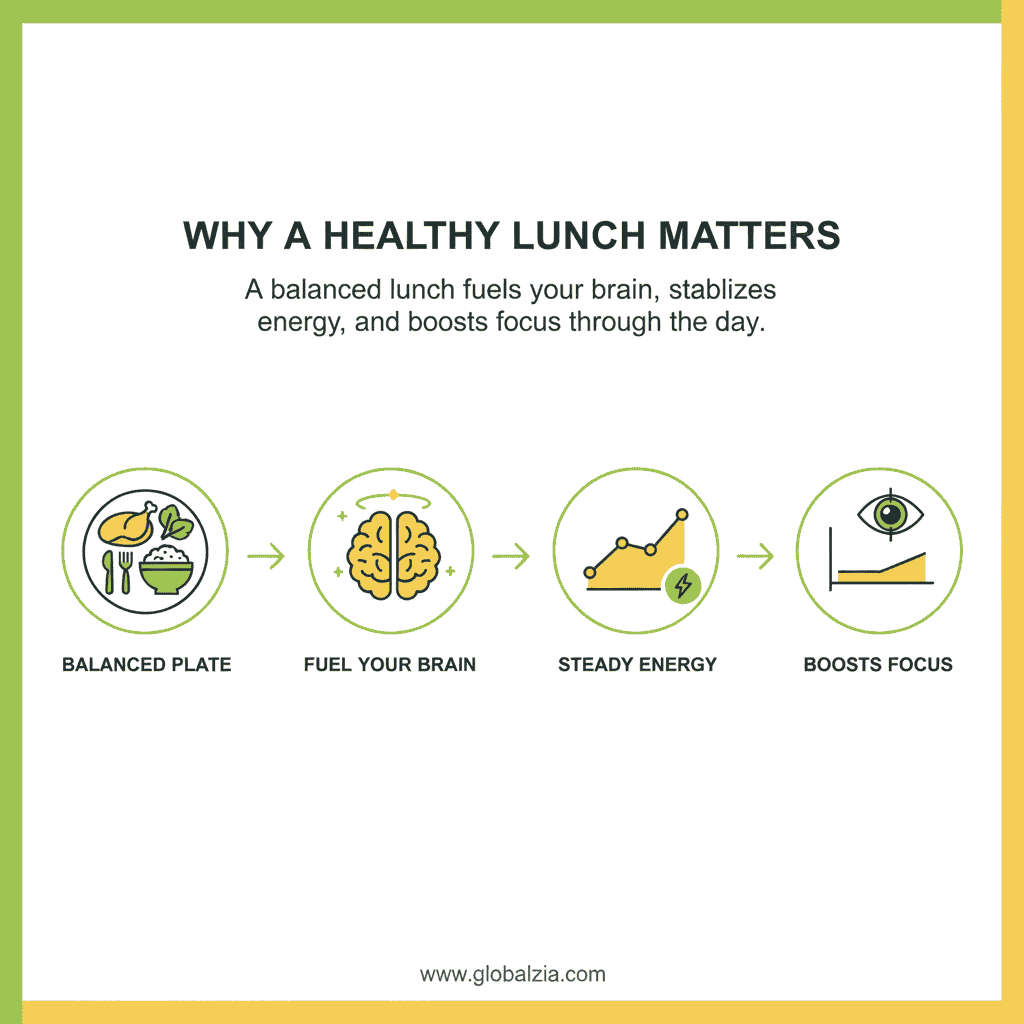
How Lunch Impacts Your Energy and Focus
A well-balanced lunch stabilizes blood sugar, preventing energy crashes that often follow heavy or sugary meals. Complex carbohydrates from whole grains, combined with lean proteins and healthy fats, release energy slowly, helping you stay alert and productive.
Skipping lunch or choosing nutrient-poor options can cause fatigue, irritability, and decreased concentration. Studies from nutrition institutes consistently show that people who eat balanced lunches perform better in problem-solving tasks and maintain steady moods through the afternoon.
Quick takeaway: A nutrient-dense lunch = sharper focus, better energy, and improved mood stability.
Key Nutrients Your Midday Meal Should Include
Your body needs a mix of macronutrients and micronutrients to perform at its best. The following are essential building blocks for a healthy midday plate:
- Protein: Supports muscle repair and keeps you full longer. Choose chicken, lentils, chickpeas, tofu, eggs, or Greek yogurt.
- Complex Carbohydrates: Provide sustained energy. Opt for brown rice, quinoa, oats, or whole-grain bread.
- Healthy Fats: Aid vitamin absorption and brain function. Include avocado, olive oil, nuts, and seeds.
- Fiber: Improves digestion and controls hunger. Add vegetables, beans, and leafy greens to every meal.
- Hydrating Foods: Cucumbers, citrus fruits, and soups help maintain hydration and digestive balance.
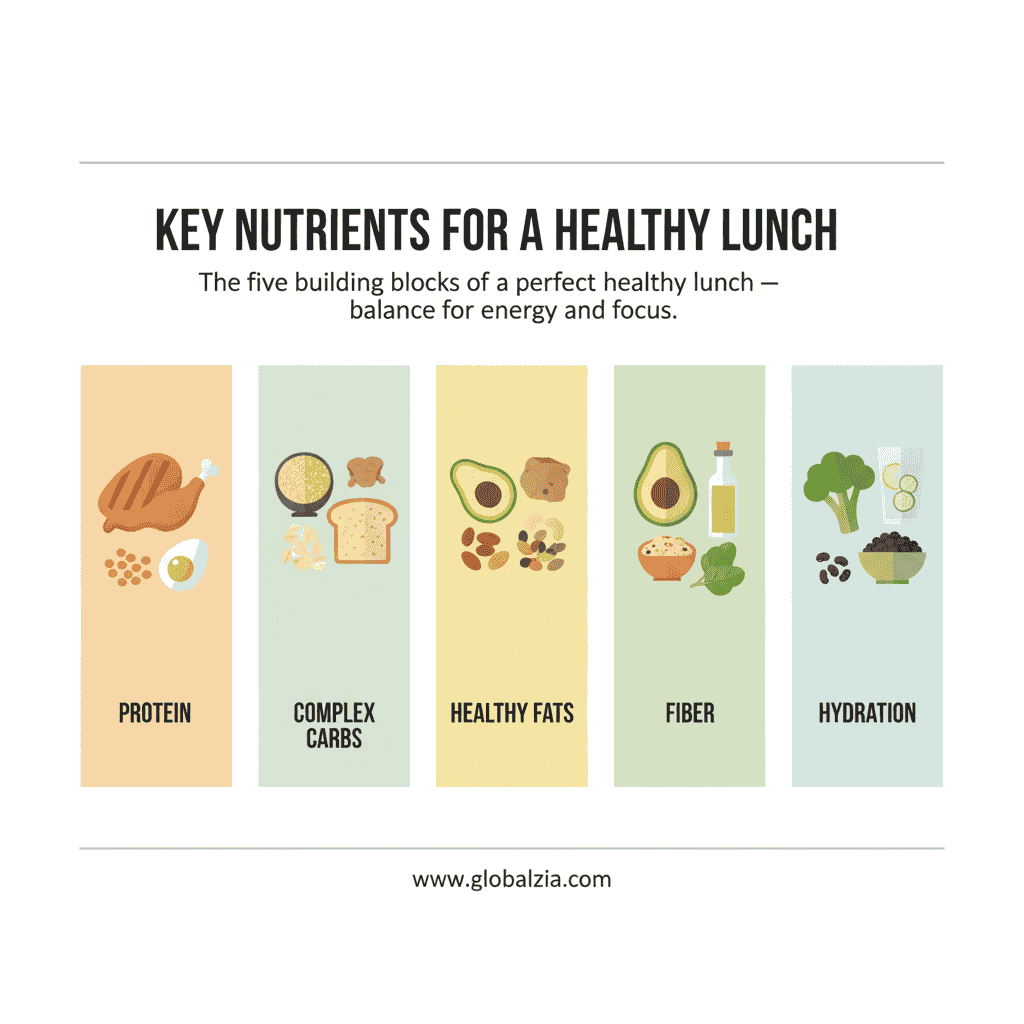
Together, these elements form a nutrient-rich foundation that keeps you energized and satisfied until dinner.
The Balance Between Taste, Time, and Nutrition
Healthy eating shouldn’t feel restrictive. The key is finding balance — combining foods that you enjoy with those that support your wellbeing. A lunch that tastes good is more sustainable than one that feels like a chore.
Plan: batch-cook grains, chop vegetables, and prepare dressings in advance. Use vibrant ingredients — herbs, spices, citrus, and seasonal produce — to make your meals exciting without adding excess calories or sodium.
In short: balance convenience with creativity. When meals are colorful, flavorful, and quick to prepare, staying consistent with healthy eating becomes effortless.
How to Build a Perfect Healthy Lunch
Building a healthy lunch is less about restriction and more about composition. When every element on your plate serves a purpose — fueling, nourishing, and satisfying — eating well becomes second nature. The ideal lunch blends taste, texture, and nutrition in a way that fits effortlessly into your daily routine.
Below is a clear framework to help you build balanced, energizing meals every day.
The Formula — Protein + Fiber + Good Fats
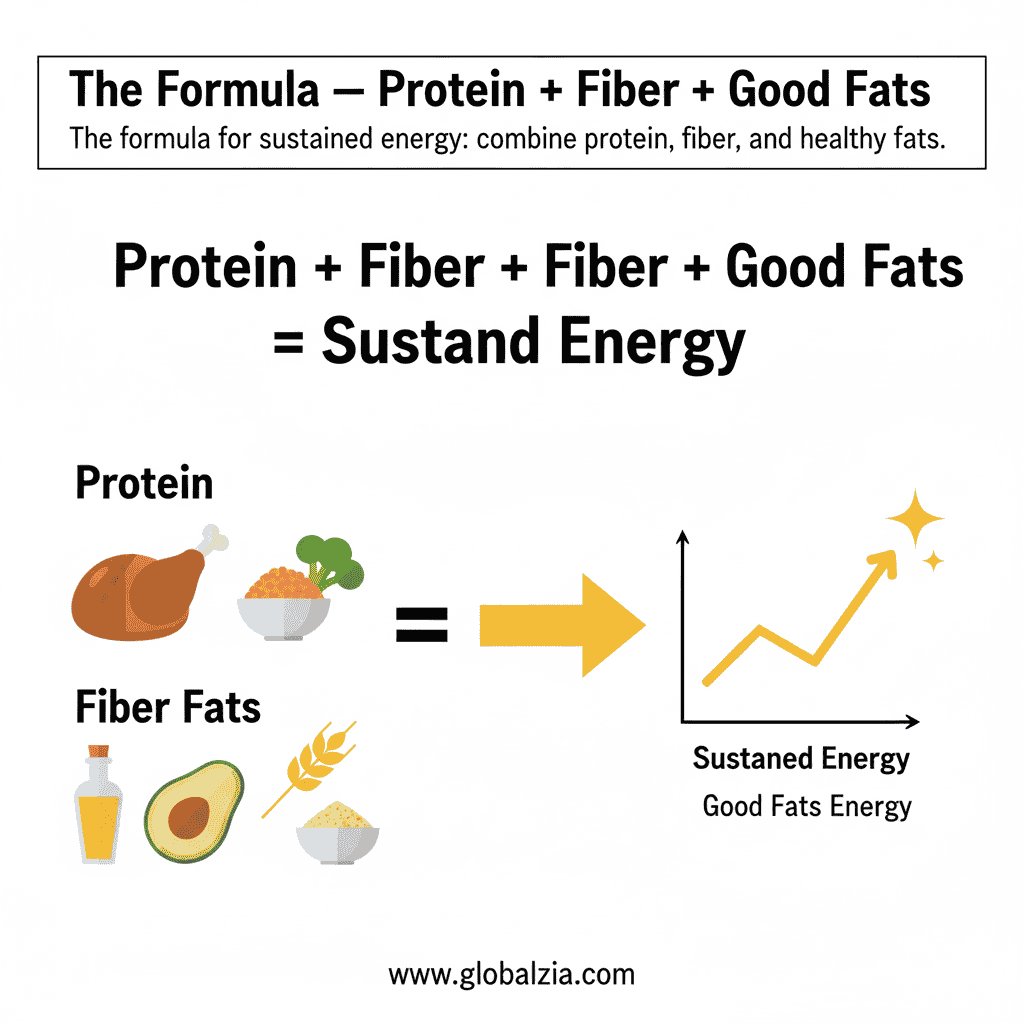
Think of your lunch plate as a simple, three-part equation: Protein + Fiber + Good Fats = Sustained Energy.
This combination keeps you full, stabilizes blood sugar, and supports muscle and brain function throughout the afternoon.
Protein: Choose lean sources like grilled chicken, tuna, eggs, paneer, lentils, or tofu. Protein repairs tissue and helps curb unnecessary snacking.
Fiber: Add vegetables, legumes, and whole grains. Fiber slows digestion, keeping you satisfied for longer.
Healthy Fats: Avocado, olive oil, chia seeds, nuts, and tahini provide flavor and help your body absorb vitamins A, D, E, and K.
Quick example: a quinoa bowl topped with chickpeas, roasted vegetables, and a drizzle of olive oil offers all three components — and can be made in under 15 minutes.
The perfect healthy lunch combines protein, fiber, and good fats — a trio that keeps energy steady and hunger controlled.
Portion Control and Calorie Balance
Even the healthiest meals can slow you down if portions are oversized. The goal is balance, not minimalism. Understanding portion sizes ensures your body gets enough fuel without unnecessary excess.
- Half the plate: colorful vegetables or salad greens (low-calorie, high-fiber).
- One-quarter: lean protein such as fish, beans, or poultry.
- One-quarter: complex carbohydrates like quinoa, sweet potato, or whole-grain bread.
- A small portion: healthy fats — about one tablespoon of olive oil, a handful of nuts, or half an avocado.
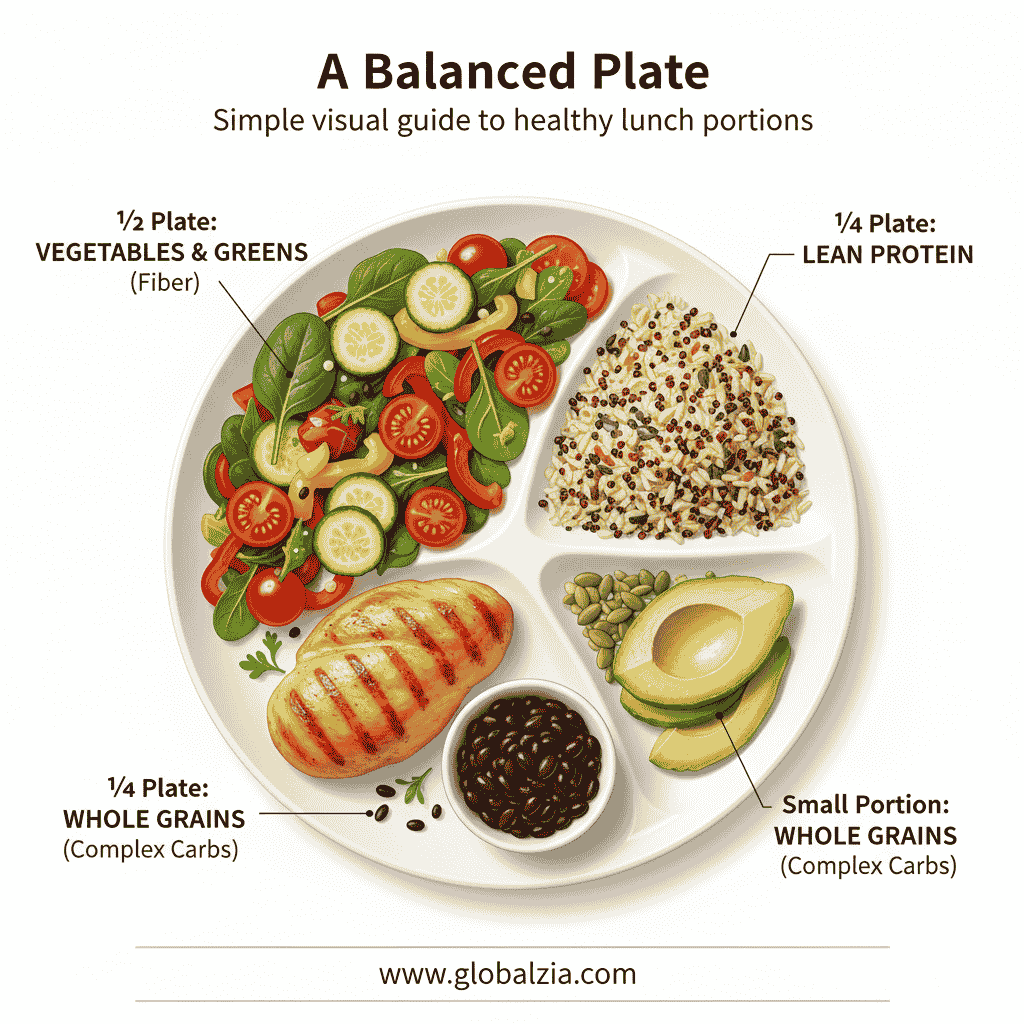
Listening to hunger cues is equally important. Eat slowly, savor each bite, and stop when you feel comfortably satisfied, not full.
Expert note: A balanced lunch typically ranges from 400 to 600 calories, depending on age, activity level, and dietary goals.
Smart Ingredient Swaps for Everyday Meals
Small swaps can transform ordinary lunches into nutrient-dense meals without losing flavor. Replace refined or heavy ingredients with lighter, whole-food alternatives that support wellness.
| Common Ingredient | Smart Swap | Why It Works |
| White rice | Brown rice or quinoa | Higher fiber, steadier energy |
| Mayonnaise | Greek yogurt or hummus | Adds protein, cuts saturated fat |
| White bread | Whole-grain wrap or multigrain toast | Increases fiber and minerals |
| Sugary drinks | Infused water or green tea | Reduces sugar, hydrates better |
| Creamy dressing | Olive oil + lemon or tahini sauce | Healthy fats, cleaner flavor |
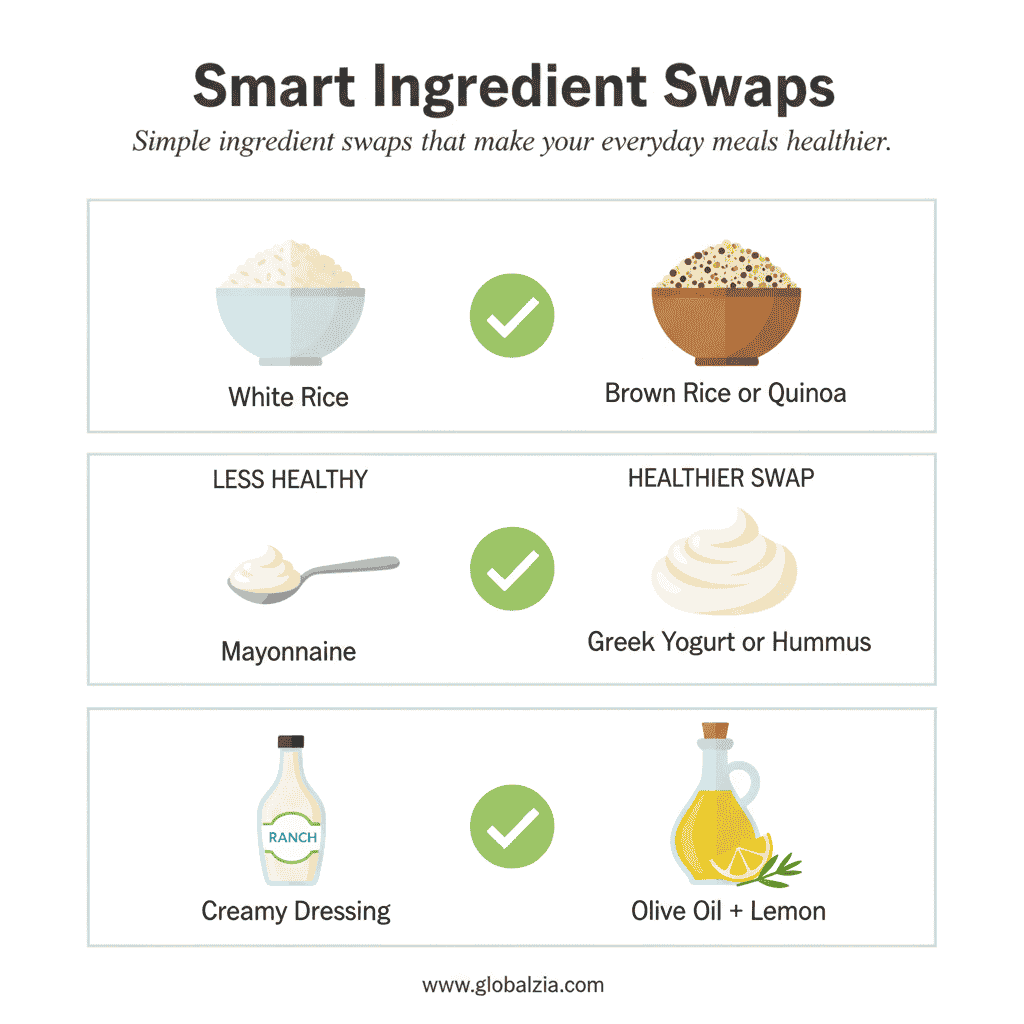
These swaps enhance flavor, improve texture, and align with heart-healthy and weight-management goals — without sacrificing satisfaction.
In short: Building the perfect lunch is about mindful balance. When you combine macronutrients wisely, control portions, and choose smarter ingredients, healthy eating feels effortless, not restrictive.
Quick & Easy Healthy Lunch Ideas
Healthy eating should be simple enough to fit into real life. Whether you’re racing between meetings or feeding a family, quick lunches can be both nourishing and delicious. The key lies in using wholesome ingredients that need little cooking but deliver maximum flavor and nutrition.
Below are time-saving lunch ideas that require minimal effort and no compromise on quality.
10-Minute Meals for Busy Days
You don’t need hours to prepare a meal that fuels your day — just a few balanced ingredients and smart assembly. Ten minutes is plenty to put together a meal that’s colorful, satisfying, and nutritionally complete.
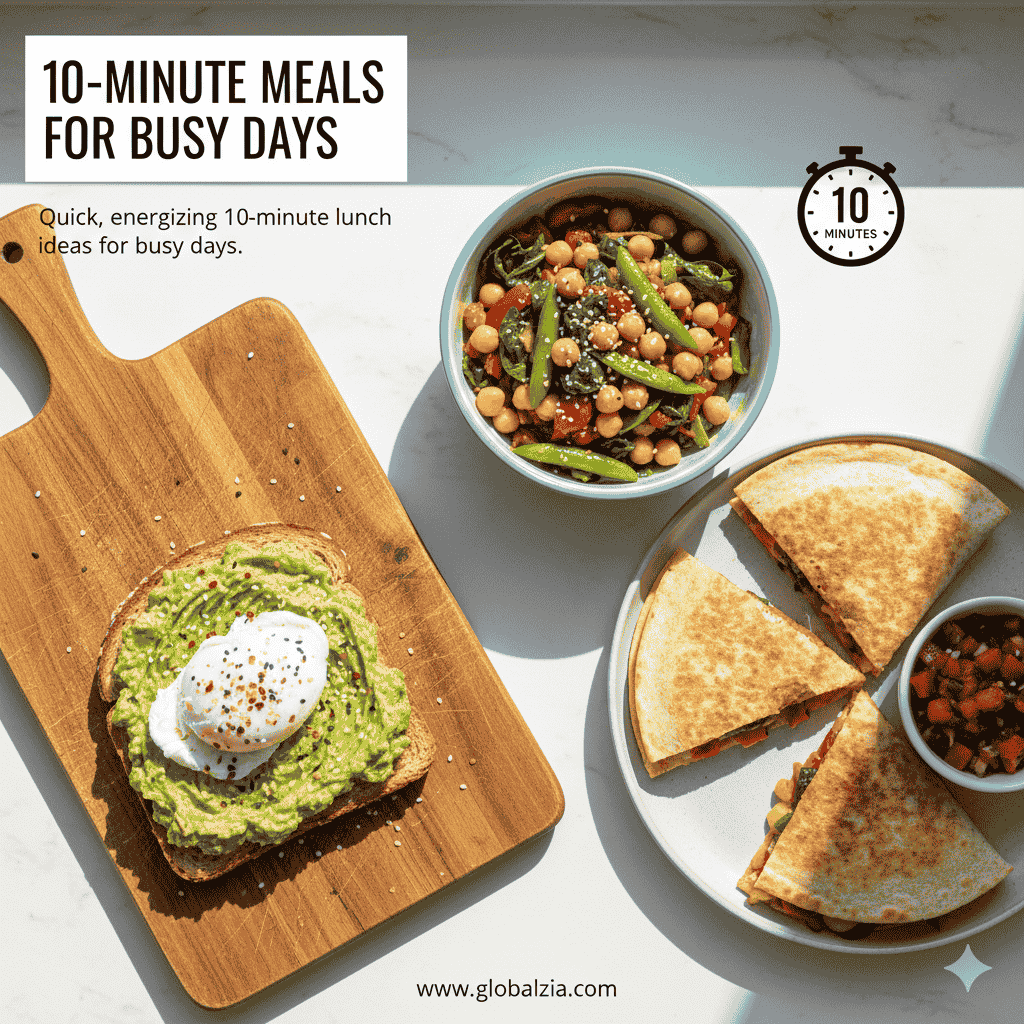
Try these quick combinations:
- Mediterranean tuna salad: Canned tuna, chickpeas, cucumber, cherry tomatoes, and olive oil tossed with lemon and herbs.
- Egg and avocado toast: Whole-grain toast topped with mashed avocado, poached egg, and chili flakes.
- Chickpea stir-fry: Sauté chickpeas with garlic, spinach, and a splash of soy sauce — serve over leftover brown rice.
- Vegetable quesadilla: Whole-wheat tortilla filled with cheese, beans, and bell peppers — cooked in a skillet for 3–4 minutes per side.
Each recipe uses familiar pantry ingredients and focuses on protein + fiber + good fats, ensuring sustained energy.
You can make a healthy 10-minute lunch by combining lean proteins, vegetables, and whole grains—like tuna salad, egg toast, or a quick chickpea stir-fry.
No-Cook Lunches That Still Satisfy
When there’s no time to cook, freshness becomes your best ally. A few raw, ready-to-eat ingredients can transform into a complete, refreshing meal.

Ideas to try:
- Greek yogurt parfait: Layers of yogurt, berries, nuts, and a drizzle of honey — balanced and portable.
- Hummus and veggie wraps: Spread hummus on a whole-grain tortilla, add sliced cucumbers, carrots, and greens, then roll tight.
- Lentil salad jar: Pre-cooked lentils mixed with diced bell peppers, parsley, olive oil, and lemon juice.
- Caprese bowl: Fresh mozzarella, tomatoes, basil, olive oil, and balsamic vinegar — quick and naturally satisfying.
To elevate flavor, use herbs, citrus, and seeds instead of processed sauces. Each bite delivers nutrients, fiber, and hydration — ideal for warm days or busy offices.
Tip: Prep ingredients in batches at the start of the week so you can mix and match combinations without cooking each day.
One-Bowl Wonders and Bento-Box Combos
Single-bowl meals and bento-style lunches combine balance and creativity. They’re portion-controlled, visually appealing, and make it easy to include diverse food groups in one dish.
One-bowl inspirations:
- Quinoa power bowl: Base of quinoa with grilled vegetables, black beans, and a tahini dressing.
- Asian noodle salad: Soba noodles, shredded carrots, edamame, and sesame dressing for a refreshing twist.
- Chicken burrito bowl: Brown rice, beans, corn, salsa, and grilled chicken topped with avocado slices.
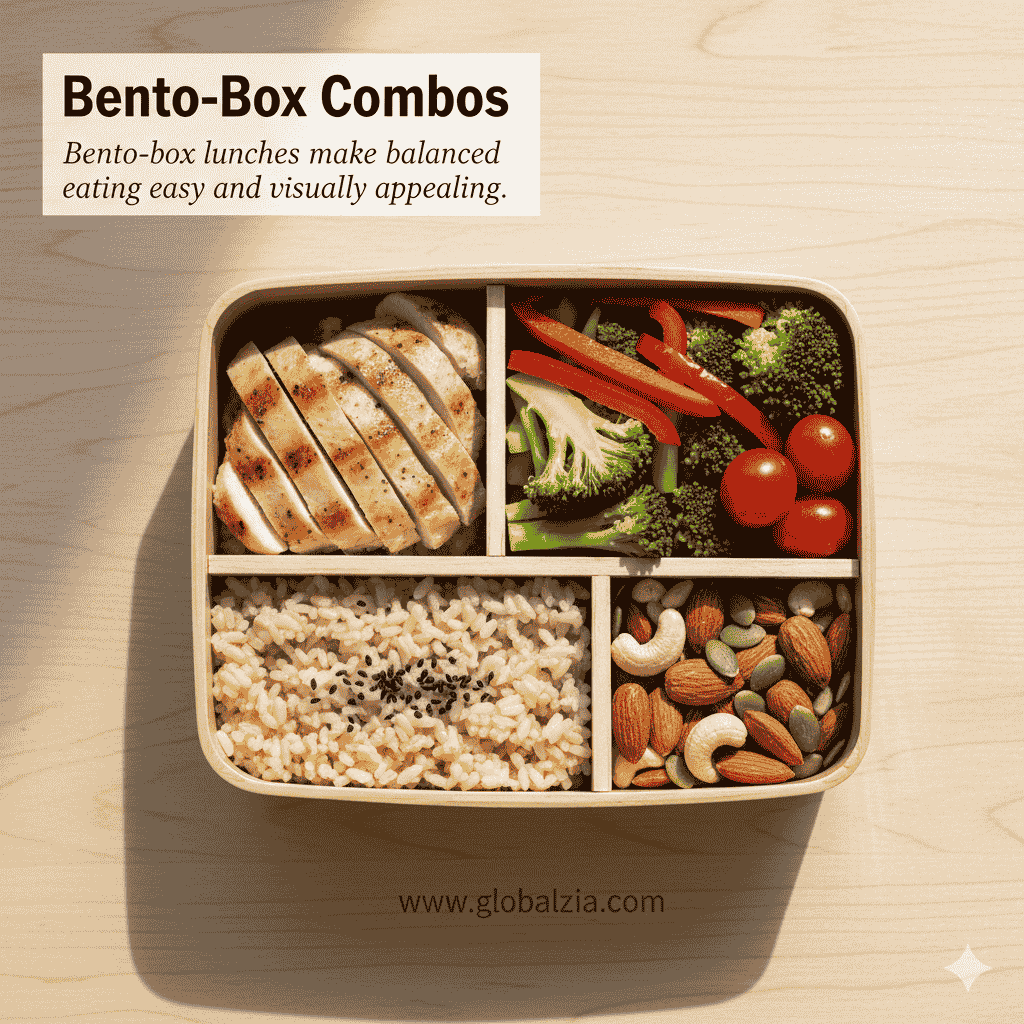
Bento-box ideas:
- Section 1: Hard-boiled egg or grilled tofu (protein)
- Section 2: Brown rice or whole-grain pasta (complex carbs)
- Section 3: Steamed broccoli, cherry tomatoes, or fruit (fiber & vitamins)
- Section 4: Handful of nuts or seeds (healthy fats)
These lunches travel well, stay fresh, and keep portions balanced — perfect for work, school, or picnics.
A one-bowl or bento lunch combines grains, proteins, vegetables, and healthy fats in one balanced, easy-to-pack meal.
Heart-Healthy Lunch Recipes
Eating for your heart doesn’t mean giving up flavor or satisfaction. The goal is to create lunches that nourish your body, support circulation, and keep cholesterol and blood pressure in check — all while tasting genuinely delicious.
A heart-healthy lunch emphasizes whole grains, lean proteins, fiber-rich vegetables, and healthy fats. These ingredients help reduce inflammation, manage weight, and boost long-term vitality.
Low-Sodium and Low-Cholesterol Options
Low-sodium and low-cholesterol lunches focus on fresh produce, lean proteins, and natural seasonings instead of processed foods or added salt.
A diet lower in sodium and saturated fats can significantly lower the risk of heart disease and hypertension. Focus on fresh ingredients and herb-based flavors to enhance meals without relying on heavy dressings or salty condiments.
Examples of low-sodium, low-cholesterol lunches:
- Grilled salmon with quinoa and roasted vegetables: Omega-3s from salmon support heart rhythm stability.
- Chickpea and spinach salad: High in plant-based protein and fiber to reduce LDL cholesterol.
- Turkey and avocado wrap: Uses lean meat and healthy fats from avocado for satiety.
- Vegetable soup with barley: Naturally low in sodium when seasoned with garlic, parsley, and thyme instead of salt.
Expert tip: Replace deli meats with roasted chicken breast or lentils; swap creamy dressings for olive oil and lemon.
Whole Grains, Lean Proteins, and Healthy Oils
A heart-healthy lunch combines whole grains, lean proteins, and oils rich in unsaturated fats to support circulation and cholesterol balance.
Whole grains like brown rice, quinoa, bulgur, and oats provide steady energy and fiber to regulate cholesterol levels.
Lean proteins such as fish, beans, chicken, or tofu add amino acids essential for muscle repair and heart function.
Healthy oils — particularly olive, avocado, and flaxseed oil — deliver monounsaturated fats that reduce inflammation.
Balanced meal ideas:
- Mediterranean grain bowl: Quinoa, chickpeas, cucumbers, tomatoes, olives, and olive oil dressing.
- Grilled chicken and farro salad: Packed with fiber and minerals for sustained energy.
- Tofu and vegetable stir-fry: Uses sesame oil and ginger for depth of flavor without excess sodium.
- Tuna and olive tapenade sandwich: On whole-grain bread with arugula for a peppery crunch.
Smart swaps:
- White bread → Whole-grain or oat bread
- Mayonnaise → Greek yogurt or avocado
- Butter → Olive oil drizzle
These subtle changes preserve flavor while supporting cardiovascular wellness.
Best Lunches for Work and Office
The best heart-healthy lunches for work are easy to prep, travel-friendly, and rich in fiber, protein, and healthy fats.
Lunch at work doesn’t have to mean fast food or vending machines. With minimal prep, you can pack meals that protect heart health and keep you focused through the afternoon slump.
Top portable ideas:
- Lentil and roasted vegetable salad: Rich in potassium and magnesium for blood pressure control.
- Grilled chicken wrap with hummus: A protein-rich, fiber-packed lunch that stays fresh for hours.
- Brown rice sushi rolls: Pair avocado, cucumber, and smoked salmon for omega-3 goodness.
- Whole-grain pasta with tomato-basil sauce: A simple, reheatable option packed with lycopene antioxidants.
Storage tip: Keep dressings separate in small containers to maintain freshness and reduce sogginess.
Expert note: Regularly eating balanced, heart-friendly lunches improves mood and focus — vital for high-performance workdays.
Vegetarian & Vegan Lunch Ideas
Plant-based lunches are vibrant, satisfying, and nutritionally complete when built with the right balance of proteins, fiber, and healthy fats. Whether you’re vegetarian, vegan, or simply adding more plants to your diet, these ideas deliver variety, taste, and long-lasting energy without relying on animal products.
Eating this way not only supports personal health but also promotes sustainability — reducing your carbon footprint while increasing your nutrient diversity.
High-Protein Plant-Based Meals
High-protein vegetarian meals combine legumes, tofu, quinoa, and seeds to deliver the essential amino acids your body needs for strength and energy.
Many people assume plant-based diets lack protein — but that’s far from true. With smart ingredient combinations, you can meet all your protein requirements easily.
Top high-protein vegetarian combinations:
- Quinoa + Black Beans: A complete protein loaded with fiber and iron.
- Tofu Stir-Fry with Vegetables: Contains all nine essential amino acids and calcium.
- Lentil and Spinach Curry: High in folate and magnesium for energy and recovery.
- Chickpea Salad Sandwich: A protein-rich alternative to tuna or chicken salad.
- Greek Yogurt Parfait with Nuts & Seeds (Vegetarian): Perfect balance of protein, probiotics, and healthy fats.
Pro tip: Combine grains with legumes (e.g., rice + lentils, hummus + pita) to ensure complete amino acid profiles — a core principle of balanced vegan nutrition.
Colorful Veggie Bowls and Wraps
Colorful veggie bowls and wraps combine vibrant produce, grains, and sauces for balanced, nutrient-packed lunches that delight both the eyes and taste buds.
Color is your best nutrition guide — every shade represents a unique set of antioxidants, vitamins, and minerals. A well-composed bowl or wrap not only satisfies hunger but also delivers visual joy and texture contrast.
Examples of vibrant combinations:
- Rainbow Buddha Bowl: Roasted sweet potatoes, kale, quinoa, red cabbage, and tahini-lime dressing.
- Mediterranean Wrap: Hummus, cucumbers, tomatoes, olives, spinach, and a drizzle of olive oil.
- Asian-Inspired Veggie Bowl: Brown rice, edamame, carrots, red peppers, and sesame-ginger sauce.
- Grilled Halloumi Salad (Vegetarian): High in calcium and protein with fresh herbs and lemon.
Visual tip: Mix at least three colors per meal — red, green, and orange vegetables ensure a range of antioxidants and phytonutrients essential for heart and immune health.
Easy Legume-Based Recipes
Legume-based lunches like lentil soups, bean salads, and hummus bowls provide fiber, iron, and plant protein for sustained energy.
Legumes — such as lentils, chickpeas, and beans — are nutrient powerhouses rich in fiber, B vitamins, and plant protein. They’re budget-friendly, versatile, and ideal for make-ahead lunches.
Simple legume-centered meals:
- Lentil Soup with Vegetables: Warm, comforting, and protein-packed.
- Three-Bean Salad with Lemon Vinaigrette: A classic dish that’s quick, refreshing, and nutrient-dense.
- Hummus Bowl with Roasted Veggies: Great for meal prep and full of creamy texture and flavor.
- Spicy Chickpea Wraps: Crunchy, tangy, and ready in under 10 minutes.
- Black Bean Burrito Bowl: Paired with brown rice, salsa, and avocado for balanced energy.
Health note: Regularly eating legumes can help lower LDL cholesterol and maintain stable blood sugar — making them ideal for heart and digestive health.
Plant-based meals prove that healthy eating can be indulgent, flavorful, and deeply nourishing — no compromise required. By combining texture, color, and nutritional intent, vegetarian and vegan lunches redefine what wholesome food looks like.
Family-Friendly Lunches
Healthy eating starts at home — and the best lunches bring the whole family together. Whether you’re packing a school lunchbox, feeding a picky eater, or preparing weekday meals on a budget, the key is to make nutritious food fun, balanced, and approachable.
Family-friendly lunches focus on color, simplicity, and taste — meals that are easy to prepare, store well, and appeal to both kids and adults.
Healthy Lunchbox Ideas for Kids
Healthy lunchboxes for kids include balanced portions of protein, whole grains, fruits, and vegetables — arranged in colorful, fun ways that encourage better eating.
Children need consistent energy and nutrients to stay focused at school. A thoughtful lunchbox fuels growth, boosts concentration, and helps build healthy lifelong habits.
Smart lunchbox components:
- Main: Whole-grain wrap with turkey, cheese, or hummus
- Sides: Apple slices, carrot sticks, or cherry tomatoes
- Snack: Yogurt cup, boiled egg, or trail mix
- Drink: Water or milk (avoid sugary drinks)
Creative tip: Use bento-style boxes or small containers to separate foods by color and texture — making the meal more inviting and less messy.
Balanced example:
A mini pita sandwich with hummus and cucumber, a handful of berries, a small cheese cube, and a few whole-grain crackers — easy, balanced, and lunch-box-safe.
Balanced Lunches That Even Picky Eaters Love
The secret to feeding picky eaters is offering familiar flavors with subtle healthy upgrades — keeping meals simple, colorful, and fun to eat.
Picky eaters often reject foods based on texture or unfamiliar tastes. The solution? Combine favorites with nutritious twists.
Kid-approved ideas:
- Mac and Cheese Upgrade: Use whole-grain pasta with pureed cauliflower in the sauce.
- Mini Quesadillas: Whole-wheat tortillas filled with beans, cheese, and veggies.
- Hidden-Veggie Muffins: Add grated carrots or zucchini for extra fiber.
- Homemade Chicken Nuggets: Oven-baked using oat or almond flour for crunch.
- Smoothie Bowls: Blend banana, spinach, and yogurt — top with granola or fruit slices.
Chef’s insight: When introducing new foods, pair them with familiar items. For example, serve broccoli alongside pasta or add spinach to a well-liked sandwich.
Budget-Friendly Options for Families
Affordable healthy lunches rely on pantry staples like beans, eggs, rice, and seasonal produce — proving that good nutrition doesn’t have to be expensive.
Nutritious meals can fit every budget with smart planning and simple ingredients. Buying in bulk, choosing frozen vegetables, and prepping ahead saves both money and time.
Low-cost, family-approved lunch ideas:
- Egg Fried Rice with Vegetables: Uses leftover rice and frozen peas.
- Chickpea Salad Sandwiches: High in protein, low in cost.
- Pasta with Tomato-Lentil Sauce: A hearty, wallet-friendly twist on spaghetti.
- Omelet Wraps: Fill with leftover vegetables for a fast, filling meal.
- Vegetable Soup and Whole-Grain Bread: Great for large batches and freezing.
Money-saving tips:
- Plan weekly menus and repurpose leftovers.
- Buy seasonal fruits and vegetables for better prices and taste.
- Use reusable containers to reduce waste and costs over time.
These meals nourish growing families without straining the budget — blending practicality with nutrition.
Meal Prep & Make-Ahead Healthy Lunches
A well-planned lunch routine transforms healthy eating from a daily challenge into an effortless habit. Meal prep helps you save time, reduce food waste, and avoid the stress of last-minute choices.
Whether you cook once a week or batch-prep for a few days, these strategies help you stay consistent, organized, and energized.
How to Plan and Prep for the Week
Weekly meal prep starts with a balanced menu, portion control, and proper storage — helping you eat healthy, save money, and reduce weekday stress.
Step-by-step approach to effective meal prep:
- Plan your menu: Choose 3–4 versatile recipes that share ingredients (like grains, proteins, and vegetables).
- Batch cook staples: Cook grains (quinoa, rice, or pasta), roast a tray of vegetables, and prepare proteins like grilled chicken or lentils.
- Portion smartly: Divide meals into individual containers to ensure consistent calorie intake and easy grab-and-go options.
- Use labeling: Mark containers with the date and meal type — helps maintain freshness and avoid food waste.
- Keep it varied: Rotate sauces, herbs, or side dishes to prevent boredom and maintain nutrient diversity.
Example weekly prep idea:
- Monday–Tuesday: Mediterranean quinoa bowls
- Wednesday: Chickpea salad wraps
- Thursday: Brown rice with roasted vegetables
- Friday: Veggie stir-fry with tofu and sesame dressing
Chef’s tip: Always let cooked food cool before sealing it — trapping steam can cause sogginess and shorten freshness.
Storing and Reheating Tips to Keep Food Fresh
Store meal-prepped lunches in airtight, portioned containers and reheat gently to maintain flavor, texture, and nutrients.
Proper storage keeps food safe, flavorful, and ready when you are.
Follow the “2-hour rule” — refrigerate cooked meals within two hours of preparation to prevent bacterial growth.
Storage guidelines:
- Refrigeration: Keep meals in airtight glass or BPA-free containers. Consume within 3–4 days.
- Freezing: Freeze soups, grains, and proteins in portioned bags for up to 2 months.
- Moisture control: Store sauces or dressings separately to preserve crunch and texture.
- Reheating: Use microwave-safe glass containers or a skillet with a splash of water to restore freshness. Avoid repeated reheating of the same portion.
Freshness tip: Line containers with a paper towel for greens or wraps — it absorbs moisture and prevents wilting.
Food-safety note: Foods like cooked rice, poultry, and seafood should always be reheated above 75°C (165°F) before eating.
Time-Saving Tools and Kitchen Essentials
The right kitchen tools — like meal prep containers, sharp knives, and efficient cookers — make healthy eating quicker and more enjoyable.
Investing in simple, reliable tools streamlines prep and minimizes cleanup. You don’t need a chef’s kitchen — just a few efficient essentials.
Meal-prep must-haves:
- Glass or BPA-free containers: Preserve freshness and make portions visible.
- Sharp chef’s knife: Speeds up chopping and ensures uniform cooking.
- Cutting boards (color-coded): Prevent cross-contamination between proteins and produce.
- Non-stick skillet or air fryer: Perfect for quick reheating or crisping leftovers.
- Instant Pot or slow cooker: Set-and-forget convenience for grains, soups, or curries.
- Digital kitchen scale: Helps manage portions for calorie balance.
Time-saving strategies:
- Pre-cut vegetables and store them in airtight containers for 3 days.
- Cook proteins in bulk, then freeze in meal-sized portions.
- Prepare dressings and sauces in advance for quick flavor upgrades.
Expert insight: A few organized prep sessions each week can save up to 5 hours of cooking time and help you maintain consistent nutrition.
International Healthy Lunch Inspirations
Healthy eating has no borders — every culture offers its own wisdom on balance, flavor, and nourishment. Exploring global cuisines is an easy way to keep lunches exciting, diverse, and nutrient-rich.
From Mediterranean freshness to Asian comfort bowls and creative fusions, these meals prove that eating well can be both adventurous and deeply satisfying.
Mediterranean Lunches Full of Flavor
Mediterranean lunches feature olive oil, whole grains, fresh vegetables, and lean proteins — a heart-healthy combination celebrated for taste and longevity.
The Mediterranean diet is widely recognized for promoting heart health, energy, and longevity. It focuses on whole foods, healthy fats, and vibrant seasonal ingredients, creating meals that are both light and fulfilling.
Classic Mediterranean lunch ideas:
- Greek Grain Bowl: Quinoa, chickpeas, cucumbers, tomatoes, olives, and feta with a lemon-olive oil drizzle.
- Hummus and Roasted Vegetable Wrap: High in fiber, iron, and antioxidants.
- Tuna Niçoise Salad: A mix of tuna, green beans, boiled eggs, potatoes, and olives — rich in omega-3s.
- Lentil Soup with Spinach and Garlic: A warm, protein-packed meal for cooler days.
- Caprese Pita Pocket: Mozzarella, tomato, basil, and balsamic — quick and refreshing.
Chef’s insight: Mediterranean meals are ideal for meal prep; their flavors intensify over time, and most dishes taste delicious both cold and warm.
Asian-Inspired Nourish Bowls
Asian-inspired nourish bowls combine rice, vegetables, and lean proteins with aromatic sauces — creating balanced meals rich in flavor and texture.
Asian cuisines are masters of balance and contrast — savory, sweet, spicy, and umami come together in nutrient-dense combinations. These bowls are versatile, easy to customize, and perfect for work lunches.
Popular Asian-inspired lunch ideas:
- Teriyaki Salmon Bowl: Brown rice, edamame, steamed broccoli, and sesame-ginger glaze.
- Thai Peanut Noodle Salad: Rice noodles tossed with colorful vegetables and a creamy peanut-lime sauce.
- Korean Bibimbap: A mix of sautéed vegetables, fried egg, and gochujang sauce over brown rice.
- Tofu Stir-Fry with Garlic and Ginger: Packed with antioxidants and plant protein.
- Miso Soup with Whole-Grain Soba Noodles: Comforting, light, and full of probiotics.
Flavor note: Use low-sodium soy sauce, miso, sesame oil, and rice vinegar for authentic yet heart-conscious seasoning.
Global Fusion Recipes to Try
Fusion recipes combine global ingredients and techniques to create modern, creative, healthy lunches with bold flavors and balanced nutrition.
Global fusion cooking celebrates innovation — blending cultural elements for exciting, nutritious meals. It’s perfect for home cooks who enjoy experimenting with flavors while staying health-focused.
Creative fusion lunch ideas:
- Mexican-Style Quinoa Bowl: Black beans, corn, avocado, and lime dressing for a fiber-rich punch.
- Greek Tacos: Whole-grain tortillas filled with grilled chicken, tzatziki, and roasted peppers.
- Sushi Burrito: Brown rice, smoked salmon, avocado, and cucumber wrapped in seaweed.
- Curry Hummus Wrap: Blends Mediterranean and Indian spices with chickpeas and veggies.
- Kale and Kimchi Salad: A tangy, probiotic-rich side that pairs with any grain bowl.
Pro tip: Fusion cuisine encourages balance — when combining flavors, maintain a mix of whole grains, lean proteins, and colorful vegetables for both taste and nutrition.
In essence:
International cuisines show that healthy eating doesn’t need to be repetitive or bland. Each culture brings unique techniques and ingredients that make nutritious meals more joyful, flavorful, and sustainable.
Expert Tips for Eating Healthier at Work or School
Long workdays or study sessions often tempt us into skipping meals or grabbing processed snacks. Yet, with mindful choices and simple routines, you can stay energized, focused, and satisfied — without sacrificing convenience or taste.
Here are expert-backed ways to maintain healthy eating habits in busy environments while keeping your motivation steady.
Smart Snacking Between Meals
Smart snacks are nutrient-rich mini-meals that stabilize blood sugar, support focus, and prevent overeating at main meals.
Healthy snacks fill nutritional gaps and sustain your energy when lunch or dinner is still hours away. The key is balance — combining fiber, protein, and healthy fats for steady fuel.
Examples of smart snacks for work or school:
- Apple slices with almond butter – rich in fiber and good fats.
- Greek yogurt with berries – protein-packed and antioxidant-rich.
- Roasted chickpeas or mixed nuts – portable, crunchy, and satisfying.
- Whole-grain crackers with hummus – a savory option for midday hunger.
- Vegetable sticks with cottage cheese dip – adds calcium and texture.
Expert tip: Pre-portion snacks into reusable containers or pouches. Keeping servings in check prevents mindless eating while you work or study.
Hydration and Mindful Eating Habits
Staying hydrated and eating mindfully enhances digestion, focus, and energy levels while preventing unnecessary snacking.
Dehydration often masquerades as hunger, leading to unnecessary calorie intake. Make hydration a habit, not an afterthought.
Hydration tips:
- Keep a refillable water bottle nearby; aim for 6–8 glasses daily.
- Infuse water with lemon, mint, or cucumber for natural flavor.
- Choose green tea or herbal tea for antioxidants and light energy.
- Limit sugary drinks and sodas that cause energy crashes.
Mindful eating is equally important. Slow down and focus on your meal — notice flavors, textures, and fullness cues. Avoid eating while scrolling or working; your brain registers satisfaction better when you’re present.
Quick mindful routine:
Take one deep breath before you start eating. Pause halfway through your meal. Ask yourself if you’re truly hungry or comfortably satisfied. This small shift helps prevent overeating and builds body awareness.
How to Stay Consistent Without Feeling Restricted
Consistency comes from balance — allowing flexibility, occasional treats, and realistic goals that make healthy eating sustainable long term.
The best healthy lifestyle isn’t about perfection; it’s about patterns. Instead of following rigid rules, adopt habits that are practical for your schedule and tastes.
Sustainable strategies:
- Follow the 80/20 rule: Eat nourishing foods 80% of the time, and enjoy treats 20% without guilt.
- Prep ahead for flexibility: Keep staples like cooked grains, pre-cut veggies, and proteins ready for quick meals.
- Listen to your body: Eat when you’re hungry, not just when the clock says it’s lunchtime.
- Celebrate small wins: Even one balanced lunch a day is progress toward better health.
Motivation tip: Pair healthy habits with positive routines — like eating lunch outdoors, listening to music, or sharing meals with friends. These associations make the habit emotionally rewarding, not restrictive.
Healthy eating at work or school is less about strict diets and more about consistency, awareness, and preparation. When your food choices align with your body’s needs and your lifestyle’s rhythm, you’ll naturally feel more energized, focused, and in control.
FAQs
What is considered a healthy lunch?
A healthy lunch includes a balance of lean protein, whole grains, fiber-rich vegetables, and healthy fats. This combination stabilizes blood sugar, supports energy levels, and keeps you full longer. Examples include grilled chicken salads, lentil soups, quinoa bowls, and wraps with hummus and veggies.
How can I make my lunch healthier without spending too much time?
Choose quick, nutrient-dense foods that require minimal prep — like canned tuna, pre-washed greens, whole-grain wraps, or overnight oats. Focus on assembly-style meals rather than cooking. Prepping ingredients once or twice a week saves time and keeps lunch effortless yet wholesome.
What are the best protein sources for a balanced lunch?
Excellent protein sources include chicken breast, tofu, lentils, eggs, Greek yogurt, and beans. Combining plant and animal proteins adds variety and essential amino acids. For on-the-go options, try chickpea salads, turkey wraps, or cottage cheese with fruit and nuts.
Are sandwiches still a healthy lunch option?
Yes — when built with whole-grain bread, lean fillings, and fresh vegetables, sandwiches can be a perfectly balanced meal. Choose grilled chicken, turkey, or hummus as the base, and skip heavy dressings or processed meats. Add leafy greens and tomatoes for extra nutrients.
What are good lunch ideas for work or school without refrigeration?
Opt for no-spoil meals like nut butter sandwiches, quinoa salads, roasted chickpeas, and whole fruits. Choose shelf-stable ingredients and use insulated lunch bags if possible. Avoid dairy-based dressings or seafood in warm conditions to keep food safe and fresh.
How can I stop feeling sleepy after lunch?
Post-lunch fatigue often comes from heavy or carb-dense meals. To avoid it, choose smaller portions, add lean protein, and include fiber-rich vegetables. Stay hydrated and take a short walk afterward — it helps with digestion and keeps energy levels steady.
What’s a good vegetarian or vegan lunch that’s high in protein?
Try lentil salads, chickpea wraps, tofu stir-fries, or quinoa-and-black-bean bowls. These meals offer complete proteins, iron, and fiber. Add avocado or nuts for healthy fats and sustained fullness throughout the afternoon.
How can I keep my lunch fresh when meal-prepping?
Store meals in airtight containers, keep dressings separate, and refrigerate promptly. Most lunches stay fresh for 3–4 days. Use glass or BPA-free containers, label with dates, and reheat only once to maintain flavor and texture.
Summery
Healthy Lunches That Nourish Your Body and Fit Your Lifestyle
Creating a healthy lunch isn’t about restriction — it’s about balance, variety, and consistency. When you fill your plate with whole foods, vibrant vegetables, lean proteins, and good fats, you fuel your body for energy and focus all day long. From simple salads and grain bowls to hearty wraps and global flavors, there’s always a nourishing option that fits your schedule and taste.
Building these small, mindful habits transforms the way you eat and feel. Whether you’re prepping for the week, packing lunches for your family, or grabbing a quick bite at work, remember: a healthy lunch is an act of self-care, not just another meal.
Start today — plan one balanced lunch for tomorrow. Your future self will thank you with better energy, sharper focus, and lasting wellness.